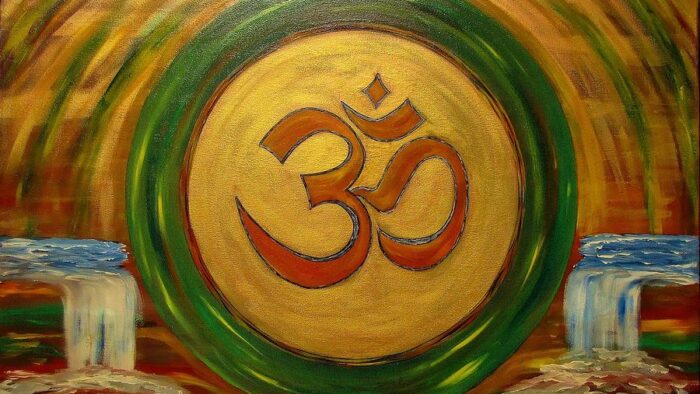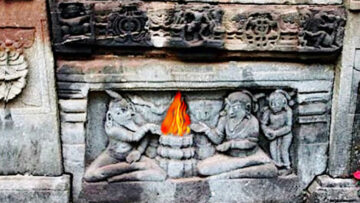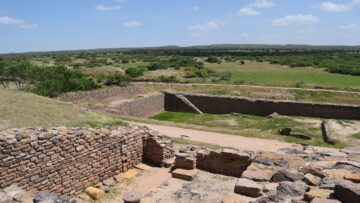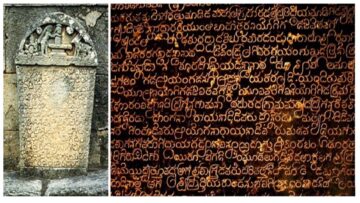1. Introduction
The purpose of this article is to classify the vast compilation of the scriptures, the Sahitya of Sanatana Dharma, in a pictorial form associated with Vedic and the post-Vedic literature that accompanied the Vedas. Sanatana is a Sanskrit word, meaning primeval, ancient, perpetual, eternal or permanent. Dharma is defined in dictionaries (V. S. Apte) as the righteous customary observances of a sect, as religion, religious abstractions and moral virtues followed by the pious. The knowledge of this holy learning has been ascribed to the Vedas, the Sanatana Sahitya – the holy scriptures of Hindus.
Since the term Hindu/Hinduism is used extensively, a brief note on why and how the term Hindu came into existence is explained in the following paragraph. The Veda, meaning knowledge of Sanatana Dharma Sahitya is thus the religious stamp of Hinduism. The Vedas are a large body of the oldest religious literature learned orally in Vedic Sanskrit that originated in the land of Bharatavarsha (approximately 5000 years back).
The civilization of that ancient period is called by historians as Vedic period. It reflects the peak period of intellectual creations, the spirit of an age in which all intellectual activity of the elite was concentrated on the performance of Yajna. Yajna involved the worship of Agni – the element fire and other deities in the sacrificial rite of yajnas making oblations to appease them.
The term “Bharata” basically means Agni, an epithet of Agni, the personification of fire as God. The followers of Agni were the sages “PutrmBharatam” (Rig Veda, 1.96.3) or Bharatas – the descendants of the land of Bharatavarsha.
The fire and ignitors of fire in the sacred altar, the priests were called the Bharatas, as both were addressed as the celestial and human priests in Rig Veda, revering the luminous or light aspect of Bharata/Agni that gives knowledge of surroundings, Bharatas were respected as people who seek and transmit knowledge.
The epicenter of this Vedic civilization was around the river Sarasvati and extended up to the Southeastern region near the river Sindhu. The term Sindhu is mentioned in the Vedas, meaning a great river like ocean and the region around that river. (Manusmriti, 2.17)
The descendants and followers of Bharata, the Bharata tribes, the elite, and noble people who followed Vedic dharma and performed noble deeds were called Aryas. Aryas were spread in Aryavarta, the land between Himalayas in North, Vindhya Mountains in the south (Manusmriti, 2.21-23) and in between the Samudra, ocean on Eastern and Western sides.
The term “Hindu” does not appear in the Vedas or Upanishads. The endonym term Sindhu used by the internal geographical residents of Bharat was mispronounced and addressed as Hindu as an exonym term, initially used by outsiders like the Greeks and the Persians, who lived beyond the Sidhu river. Hindu was only a term related to geographical distribution and not related to religion. The term Vaidika Dharma was in use for followers of Vedas.
Over a period, the term Sindhu got mispronounced as Hindu, (like the term sapta which became hapta). The land became Hindu and the inhabitants became Hindus. Later in the 19th century, the religion followed by Hindus got addressed as Hinduism. The term Hinduism was introduced in the year 1830 by the group of people who opposed British colonialism and wanted to distinguish the Vedic followers from other religions (https://en.wikipedia.org/wiki/Hinduism#Etymology).
2. The Vedas
Vedas, the oldest liturgical sacred texts, which formed the basis of Vedic religion, was compiled between BCE 1500 – 1200, an assessment that is popularly accepted. The corollary literature of Vedas was created between BCE 900-700 and further down for compilation of puranas. The exact chronology of Vedic texts is unclear. Vedas were in four branches: Rig Veda, Sama Veda, Yajur Veda and Atharva Veda.
The main theme of the four Vedas involved invoking the deities, chanting of Vedic mantras, observing the procedures of rituals with all the proceeds ministered by the chief priest. It discussed the values speculating on the origin of the universe, intention, significance, and outcome, all of which were part of the monumental literary poetic creation, the Rig Veda.
The Vedic lore, compiled much before the invention of script, was classified as ‘Shruti’ from the root word Srauta – meaning knowledge by hearing. Hindus consider Vedas to be “apaurusheya” a divine revelation, which means superhuman or divine revelations that were heard by ancient sages after meditation.
Vedas were thus the intellectual visions of sages. Hence, all the Vedas were taught and practiced by oral tradition using the faculty of hearing. The method of learning Vedas was by “Shrutaadhyayanam”. Perfection in memorization played a key role in flawless transmission. This phase of recitations being memorized by heart, communicated, and transmitted to the following generations was called “Shruti”.
The term Shruti has multiple meanings, related to hearing in general. In Vedic knowledge, it is holy learning, the subject matter of Veda. Shruti also means the foundational pitch in music to be heard before singing.
Over a period, the learning of Vedas and its ancillary branches got evolved and documented which changed from hearing to seeing and remembering, called the ‘Smriti’ phase. Smriti translates to “remembering”.
The whole body of sacred tradition of divine revelation was remembered by human teachers for analysis of legal institutes, the metre of verses, and laws of dharma, etc. The emergence of the corollaries of Vedas are very elaborate and less clearly defined for chronological order.
The Communication and learning of Vedic samhitas/scriptures starting from the initial stage are thus ascribed into two phases –1. Shruti and 2. Smriti.
Shruti Category–The Vedas, revered to be from divine origin was heard and propagated. Shruti is derived from the word shrotra meaning ‘attentively heard’. Initially, the Vedas and its explanations were learnt and communicated from generation to generation by the faculty of hearing, a quality par excellence. One who was well versed in the Vedas by Shruti method was respected as Shrotriya. The Vedas composed in Vedic Sanskrit was tough to understand. The contents, meaning, ritual and philosophical explanations were discussed as supplements or the branches.
Smriti category – is of human origin, textual material connected with Vedas of the post-Vedic period. Smriti means, that which is remembered. The wise saints created the varied analysis on the wisdom of Vedas into a body of religious texts that got classified as Smriti. The language was Sanskrit, the derivative of the Vedic Sanskrit, a refined and polished version with the perfection of grammar was used. They were attributed to an author and traditionally documented in contrast to the method of shruti.
Vedas are the perpetual and eternal basis of Hindu Sanatana Dharma. Hindus believe the origin of knowledge to be a direct revelation from the Supreme Being Brahma to different Rishis.
Veda Vyasa the greatest sage of all times compiled and arranged the divine revelations into four parts as Rig, Yajur, Sama, and Atharva Vedasamhitas and distributed it to his disciples as caretakers.
The four Vedas differed in the number of verses, theme, purpose, and mode of presentation. The category of chief priest, the Ritvija- who officiated in each branch also varied.
In this writeup, the most ancient treatise of Sanatana dharma is framed in two self-explained pictorial forms for an easy understanding of the literary creations.
In the picture diagram related to Shruti phase, the four Vedas and the scriptures are picturized using a four-petalled structure, which is the Mulaadhara – the fundamental source for Sanatana dharma. The symbol for element earth (not the shape) which is a solid square structure, unchangeable and unshakable is used as a metaphor for the Vedic knowledge.
A note about the central theme of each Veda is provided in the second circle in the diagram.The three major texts of the three branches are included in the third circle. A note on what the Samhitas, Brahmanas, Aranyakas and Upanishads mean, are in the petal form.
3. Shruti
Rig Veda: The term Rig Veda is derived from the word “Riks”, which means to praise. Rigveda was a compilation of poetry by many sages. The theme of Rig Veda was mostly oriented as an invocation to the powers of nature and its description with amazing similes. Many deities are eulogized, Indra gaining the superGod status.
The offering of Soma juice to Indra to appease him and fight against the demons was the central theme of Rig Veda. Rig Veda is divided into 10 mandalas – books, involving 10552 verses. Hotri is the chief priest of Rig Veda, who recited the sacrificial hymns to invoke the Gods.
Sama Veda is derived from the word “Saman” meaning appeasing, comforting, a word of praise and eulogizing chant. It was a liturgical collection of verses borrowed from Rigveda but sung in a complicated and the earliest form of music which was pleasant to hear. The repetitions observed in varied patterns enhanced the value of sanctity. Sama Veda has 1810 verses. Udgatri was the chief priest who sung the musical Sama chants.
Yajur Veda is derived from the root word “Yajus” meaning sacrificial formula of veneration. Though it includes many verses from Rig Veda, it was compiled more in prose order focusing on all the proceeds of the various rituals to be observed in Yajna along with the recitations of Yajus. The rituals performed on a big scale like Somayajna, Raajasuya, etc. as well as the domestic rituals were introduced in Yajur Veda and its derivative Smruti texts.
Yajur Veda is more of a guidebook for priests that are to be recited at the sacrifices containing 1875 verses in its earliest form. It was divided into two branches – Shukla and Krishna Yajurvedas. Shukla was with explanations and Krishna was in mantra form. Adhvaryu was the chief priest, a ritvija, who performed the manual duties of rituals along with the recitation of verses and formulas of Yajur Veda.
The three Vedas were recognized as canonical collections relating to the Yajnic ceremonies and theosophical in the matter.
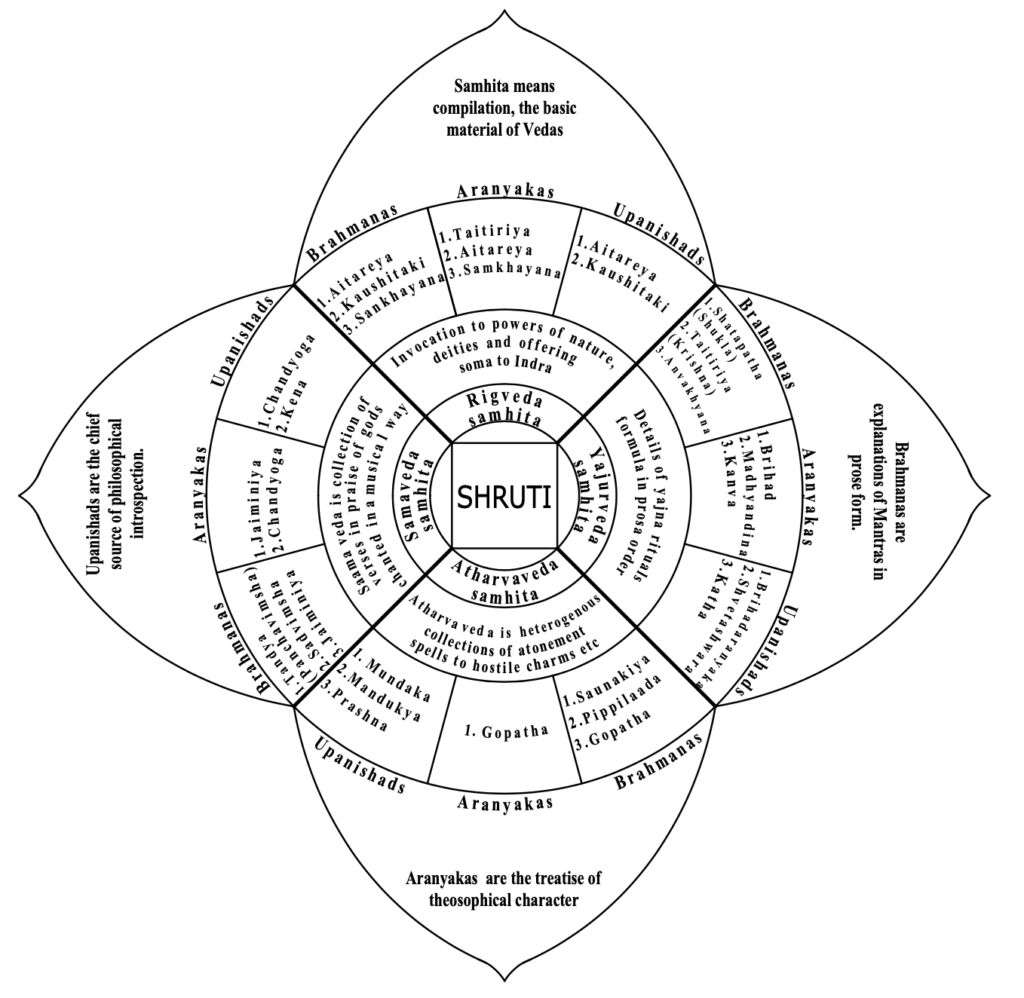
Picture 1: A concise illustration of Shruti phase of Vedic literature.
Atharva Veda, is named after Atharva Rishi who compiled it. The chief priest Brahman of this Veda supervised the yajnas and gave instructions for atonement in case of mistakes happening. Atharva Veda, the last of the four Vedas was less religious and with varied knowledge. Chants were more on superstition with heterogeneous collections of spells to hostile charms related to cure of diseases, immortality, destruction of adverse forces, securing harmony in family and villages, elimination of enemies, sorcery, the nature of supreme reality, etc. It is a compilation of 5987 verses.
4. Branches of Vedas
Vedic Sanskrit was tough to understand. Every Veda was segregated into four categories called, 1. Samhitas, 2. Brahmanas, 3. Aranyakas and 4. Upanishads for better understanding of its contents, meaning, ritual and philosophical explanations. The number of texts vary in number in each group and only three are presented belonging to each group.
Samhitas: Samhita means compilation, the basic material, the ancient collections of verses, the hymns related to euphoric rules that are methodically arranged in all Vedas.
Brahmanas: Explanations/commentaries of Mantras in prose form that describe the various ritualistic details of Samhitas. It expounds the scientific knowledge of Vedas like astronomy, geometry of fire altar construction and mystical knowledge of the Vedas. The term Brahmana is from the word Brahman – the chief priest who ministered the Yajnas. Expositions from a learned person on the significance of various rituals and the hidden philosophical meanings of the sacred text are in Brahmanas, all in similar language and style.
Aranyakas: A treatise of theosophical character which is meant to be studied in the solitude of the forest and hence called as the forest texts. It interprets the symbolic and philosophical ways associated with the rituals of sacrifice. Aranyakas are like a link between Brahmanas and Upanishads. They were intended to be studied by the ones who were initiated into Vedas, but were withdrawn to forests for vanaprastha life. As teachers they gave instructions on the inner meditative meaning of a yajna to the disciples in the gurukula in the seclusion of forests far away from the cities.
Upanishads: Upa means “nearness” and ”Nishad” means sitting, thus Upanishad means sitting near the master and listening to the mystical and philosophical contents of the Vedas. They are the highest form of philosophical introspection, spiritual knowledge, and with discussion on the concepts of Atman and Brahman. There are 108 Upanishads in general and considered as the later stage of Brahmana literature.
The four Vedas and its segregation are presented in a pictorial form for an easy understanding of the scriptures of Sanatana Dharma of Hindu religion (Hinduism). The segregations of Vedic texts are vast and vary in number from school to school.
The three most important categories are chosen in each group. The pictorial representation of the basic classification of the Shruti phase is presented below along with the names of Brahmana, Aranyaka, and Upanishad texts associated with each Veda. Readers are requested to join the terms Brahmanas or Aranyakas and Upanishads attached along with the respective name of the texts that are given in the pictorial frame.
- Branches relating to Rig Veda
a) Brahmanas
i) Aitareya Brahmana
ii) Kaushitaki Brahmana
iii) Sankhayana Brahmana
b) Aranyakas
i) Taittiriya Aranyaka
ii) Aitareya Aranyaka
iii) Samkhayana Aranyaka.
c) Upanishads
i) Aitareya Upanishad
ii) Kaushitaki Upanishad - Branches relating to SamaVeda
a) Brahmanas
i) Tandya/Panchavimsha
ii) Sadvimsha Brahmana
iii) Jaiminiya Brahmana
b) Aranyakas
i) Jaiminiya Aranyaka
ii) Chandyoga Aranyaka
c) Upanishad
i) Chandyoga Upanishad
ii) Kena Upanishad - Branches relating to Yajur Veda
a) Brahmanas
i) Shatapatha Brahmana of ShuklaYajur Veda (the brahmana literature of hundred paths)
ii) Taitiriya Brahmana, Vajasaneyibrahmana ofKrishna Yajur Veda
iii) Anvakhyana Brahmana
b) Aranyakas
i) Brihadaranyaka
ii) Madhyandina Aranyaka
iii) Kanva Aranyaka
c) Upanishads
i) Brihadaranyaka Upanishad
ii) Shvetashwara Upanishad
iii) Katha Upanishad - Branches relating to Atharva Veda
a) Brahmana
i) Saunakiya Brahmana
ii) PippilaadaBrahmana
iii) Gopatha Brahmana
b) Aranyaka
i) Gopatha Aranyaka
c) Upanishad
i) Mundaka Upanishad
ii) Mandukya Upanishad
iii) Prashna Upanishad.
5. Smriti
Smriti means “recollection”, or ‘that which is remembered’. They are the post-Vedic Sanskrit literary works of Vedic tradition that is studied by virtuous minded men. It is the derivative material texts of Vedas that elaborates, interprets and codifies the Vedic thought of how to live life in a meaningful way.
The Shruti literature is intended for the religious instruction of all Hindus containing the rules and regulations for the guidance of society. Smriti literature is a vast corpus, are totally eighteen in number, recognized by the eighteen scholars who are credited for authoring the dharma related texts. Yajnavalkya Smriti and Manusmriti were added that made the total number twenty.
The diagram of Smriti phase of literature in the second picture is metaphorically structured as a six-petalled diagram that is associated with “Svadhistana” Chakra. Svadhistana is closely related to the four-petalled Muladhara, (see picture 1), which means to ‘self-establish’ or to expand, an expression of flow, to go creative from the dormant state.
The six petals that correspond to the modes of consciousness have been correlated to the six branches of scriptures of the Smriti phase. Sanatana Dharma insists on meditation and knowledge, as a voluntary gesture to evolve with awareness. A brief note on each classification is provided for better understanding of the themes involved in each group.
Based on the nature of knowledge, Smriti literature are of two types and six branches. The two types are:
- One that outlines code of conduct.
- One that expounds shastra.
The six branches of Smriti involving both types are:
1. Purana
2. Itihaasa
3. Dharma Shastra (relates to first type)
4. Vedanga
5. Shad Darshana and
6. Upaveda (relates to second type)
1. Puranas: Puranas are the traditional legends, sacred narratives. They are an old collection of epic stories of the ancient historic legendary lore, Gods, genealogies, implying didactic and narrative matter. They are sectarian in purpose but the information on period and author are not well preserved. Puranas link Gods to men, both in religious and devotional content.
In its spiritual context, it describes the instances of God’s grace which strengthens the devotion to Gods. The cultural heritage of Bharat in its literary and archaeological fields are greatly influenced by the puranic episodes. There are eighteen puranas, classified in three major sections, each with six subcategories which establishes the diversity of manuscripts.
1. There are six Sattvik Puranas glorifying Vishnu: Vishnu, Naaradiya, Garuda, Bhaagavata, Padma, and Varaaha Puranas.
2. There are six Rajasik Puranas glorifying Lord Brahma and Agni: Brahma, Brahmanda, Brahmavaivarta, Markandeya, Bhavishyat, and Vaamana Puranas.
3. There are six Tamasika Puranas glorifying Shiva: Matsya, Kurma, Linga, Shiva, Skanda and Agni Puranas.

Picture 2: The illustration of Smriti phase of Vedic Literature
2. Itihaasa: Itihasa comprises of historical events or legends, composed in the ‘Sloka’ form, employed in Sanskrit poetry as the narrations of incidents that occurred during the lifetime of the composer, or a narration like contemporary history. The two epics Ramayana and Mahabharata are considered as Itihaasa. The focus is on righteous and ideal personality in Ramayana. Mahabharata clarifies the confusions and dilemmas of men under various situations and explains the stand that is to be followed.
Ramayana, a single homogeneous Mahakavya, narrative in nature, is composed by the seer Valmiki with 24000 slokas that are divided into seven books. Valmiki appears as a contemporary of Rama and traces the genealogy of Suryavamsha clan to which Sri Rama belonged. Ramayana is about the life of Sri Rama, the hero of Ikshvaaku family of Ayodhya, narrates his birth, adventures, marriage to Sita, expedition to Lanka and his coronation as the king. Ramayana favors worship of Sri Rama.
Mahabharata, composed by sage Vyasa is the heroic narrative describing the great 18-day battle between the descendants of Bharata, the two cousins belonging to the families of Kurus and Pandus. It consists of 100000 slokas and is the longest poetry of ancient literary history. It is didactic in teaching excessively and is divided into 18 books called ‘Parvas’. It has a supplement called Harivamsha and favors the worship of Vishnu. The philosophical poem of ‘Bhagavadgita’ is recited to the warrior Arjuna by Lord Krishna before the beginning of the battle.
It differs from Ramayana by employing introductory speech as ‘thus spake’, which is part of old prose narratives. It is a heterogeneous interpolation involving legends about Gods, kings, sages, accounts of cosmogony, disquisition of religion, law, philosophy, and duties of military caste.
3. Dharmashastras: Dharmashastras are guide books of Smriti literature dealing with the laws of righteousness. Composed in poetic verses, they are based on Dharma sutras that lead towards the development of man. They involve topics like the laws of nature, ideal virtues, morality, practices of socioreligious works, the practical codes of Dharma – the righteous way of living in all matters.
Dharmashastras are further classified as 1. Sutras, 2. Smritis, 3. Nibandhas. Dharmashastras are many, but only a few popular ones of each group are listed here:
Sutras: Like Shrauta, Grihya sutras which influenced the social life of Orthodox Hindus. Smritis: Manusmriti is the ancient legal text on the tradition of code of conduct of Hindu Dharma. Yajnavalkyasmriti was the legal theory text. Naaradasmriti is acclaimed as the best text in juridical matters. Vishnusmriti was based on devotion, the Bhakti tradition. Nibandhas treatises like Vivaha and Vyavahara are related to marriage and social responsibilities.
4. Upavedas: They are the subsidiary or subordinate class of applied Vedic knowledge, containing the subjects of technical fields of each Veda. The list of subject differs from the source. They are texts of arts and science of Vedas.
1. Ayurveda –associated with Rig Veda, deals with medicine for health and longevity.
2. Dhanurveda – associated with Yajur Veda, deals with science of archery and war.
3. Gandharvaveda- associated with Sama Veda, deals with the science of arts, music, and dance.
4. Shastra, Arthashaastra – associated with Atharva Veda deals with military technology and the science of governing by kings.
5. Shad Darshanas: They are streams of classical philosophical guidelines, windows to the truth on ultimate reality. They are insights of sages and followed by the astikas who accepted the authority of Vedas and Upanishads. It encompasses the six schools of philosophy with different approaches to attain knowledge of soul, destiny of soul, and knowledge as the path of liberation (moksha) which is the goal of life. Shad Darshanas are the six manuals of philosophy.
Each school of philosophy had its own author and literature. It is also called sutras and named
1. Nyaya sutra (Philosophy); 2. Sankhya sutra; 3. Yoga sutras; 4. Vaisheshika sutras; 5. Purvaand 6. Uttara mimamsa as Vedanta sutras.
Nyaya philosophy was created by Sage Gautama who proposed the mechanism of attaining knowledge through the five senses as the way to attain Moksha. Sankhya philosophy propounded by sage Kapila saw the rational dualistic approach of two parallel bodies, the eternal spirit Purusha – the Paramatma and consistent matter Prakruti – the Jivatma. Evolution and awareness occur by the interaction of Purusha and Prakruti. Yoga philosophy was propounded by sage Patanjali who said that the disciplining of body and mind through the practice of ashtanga yoga led to awareness that in turn led to Moksha. Vaisheshika philosophy founded by sage Kanada, called the universe as Brahman, the fundamental force of consciousness, which is divisible into finite particles of atoms, each containing a particle of consciousness. Purva mimamsa was created by sage Jaimini’s sutra, based on the power of mantras and Vedic Yajnas, said that Moksha is attainable only by following the principles prescribed in Vedas. Uttaramimamsa was founded by sage Baadarayana as the Vedanta philosophy based on Upanishads. He said that Brahman is the only reality and all things worldly are maya – unreal. In the later period, it emerged as the three branches of philosophy called:
1. Advaita (Non-dualism between Jivatma and Paramatma) by sage Shankaracharya in the 8th century.
2. Visishtadvaita (Qualified non-dualism, all Jivatma depends on Paramatma for existence) by sage Ramanujacharya in 11th century, and
3. Dvaita (Dualism, Jivatma has separate existence from Paramatma) of Madhvaacharya in the 12th century.
6. Vedangas: The Vedangas are an integral part of the Vedic system, have various supportive roles to protect the purity of Vedic form. Vedanga means the six limbs of the Veda, a certain class of work regarded as ancillary to the Vedas. The study of the Vedangas is considered necessary for the proper understanding of the Veda; hence, the Vedangas are said to be the support of the Vedas.
Ceremonial rituals of religion involved the mandatory matter of correct pronunciation, correct grammar, and correct accents. These topics formed the core of the Vedangas as a prerequisite and hence, they were considered as sacred knowledge.
The six branches are:
1. Shiksha deals with the science of phonetics, proper pronunciation of each syllable, words, and Vedic hymns. The words, its etymology, meaning, pronunciation, its grammatical part – Sandhi, the conjecture of two words and change in intonation that occurs by this conjecture is all taught in Shiksha of Vedanga.
2. Chandas deals with the meter or rhythm of the verses. It was taught to learners of Veda after the hymns were memorized in Samhita-Paatha, followed by Padapaatha of words along with the meaning of individual words. The arrangement of words in a line and structuring of the stanza was discussed in the teaching of Chandas and metre of hymns.
3. Vyaakarana or the grammatical analysis deals with the formation of words, conjunction of two words, the use of prefix and suffix of verbs and nouns, termination of nouns, etc. The four parts of speech – noun, pronoun, subject, and predicate, and the separation of these in the Sanskrit language were discussed in Vyaakarana.
4. Nirukta deals with etymology, with the meaning of complex words and phrases. It is based on the root source of words, synonyms, homonyms, interpretation, and analysis of difficult words providing insight into the hidden contents of Vedic terminologies. Nirukta imparts the ultimate and true knowledge of words.
5. Kalpa literally means sacred rules or law. It speaks of how and when sacrifices are to be conducted. Kalpa-Sutras are divided into Srautasutras and Smarthasutras. the latter are further subdivided into Grihyasutra and Dharmasutra.
6. Jyotisha plays an important role in the development of the Vedic calendar. The periods of two fortnights, the full and new moon days, the period during which a sacrifice is extended can all be seen in Jyotisha Shastra.
The first four Vedangas were meant as aids to the correct reciting and understanding of the sacred texts, the last two deals with religious rites and duties, and their proper seasons.
6. Conclusion
The Vedas are a large body of the oldest religious texts composed in Vedic Sanskrit that originated in the land of Bharatavarsha. Veda, meaning the knowledge of Sanatana Dharma, is with the religious stamp of Hinduism, the fundamental foundation on which the current Hindu religion is based. Many explanations and commentaries were created in the Smriti – post-Vedic phase which became the source to understand the oceanic nature of the knowledge of the Vedas.
Bharatiyas, the followers of Vedic traditions in Bharatavarsha, have faith and belief in God, a methodical way of offering prayers/worship sessions. The sincerity in observing the prescribed ritual pattern, dress code, religious institutions, prescribed moral values to be followed for a righteous way of living are observed by all residents and followers of Sanatana Dharma, now called Hinduism.
It is liberal in its laws and attainment of moksha/liberation is the goal attainable through individual efforts. Vedic tradition is very much a living tradition followed to this day by all Hindus in the land of Bharata and hence not just a way of living as has been categorized.
References
My sincere thanks to Mr. Prajilesh Nair from Calicut for the graphics.
-
Rekha Rao, Symbolography in Indus seals, Available online on Amazon in both eBook and Print Format: Here
-
Rekha Rao, The Truth About Aryas, Available online on Amazon in both ebook and Print Book Format:Here
- https://jigyaasaa.wordpress.com/2012/10/23/smriti-contemplation-on-the-divine-revelation
- http://www.hindupedia.com/en/Smriti
- https://www.britannica.com/topic/Rigveda
- https://byjus.com/free-ias-prep/6-orthodox-schools-hindu-philosophy
- https://en.wikipedia.org/wiki/Smriti
Featured Image Credits: Golden OM is a painting by Madhusudan Kawa – fineartamerica
Disclaimer: The opinions expressed in this article belong to the author. Indic Today is neither responsible nor liable for the accuracy, completeness, suitability, or validity of any information in the article.

